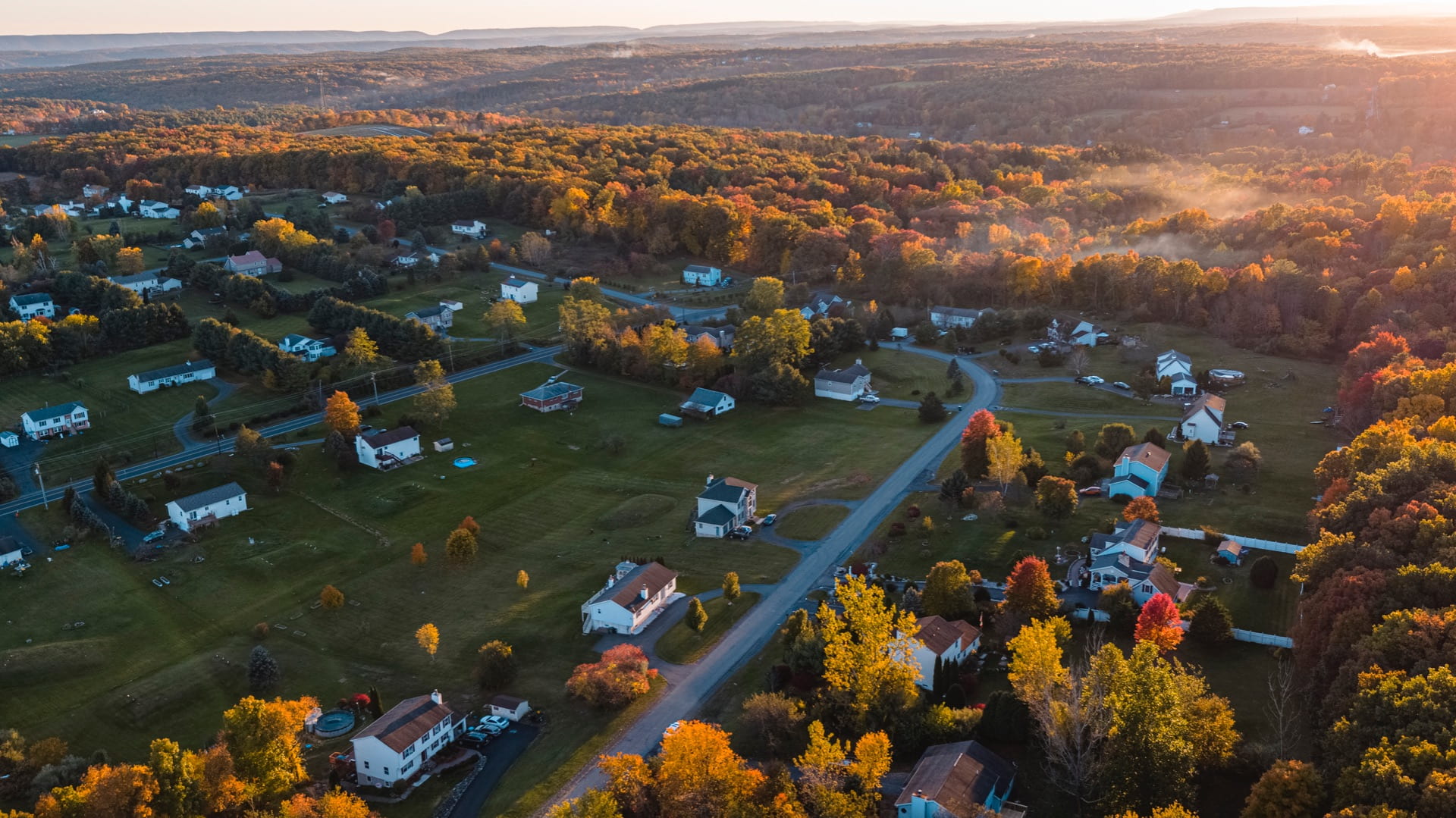Addressing Health Equity in Rural Pennsylvania
The Pennsylvania Office of Rural Health (PORH) provides technical assistance, coordination, information dissemination, and support to Pennsylvania’s rural health care providers, state and community-based agencies and associations, academic institutions, and others to expand access to care in rural areas and increase the health status of rural residents.
Lisa Davis, director of PORH and outreach associate professor of health policy and administration at Penn State, leads a team that addresses health care at the local, state, and national levels and focuses on all areas that impact health care outcomes, including agricultural health and safety.
“Rural and urban health differ in significant ways and also are intrinsically linked,” Davis said. “The primary issue in rural health is access to services, payment options for those services, transportation, and infrastructure. Twenty-three percent of Pennsylvanians live in the state’s 48 rural counties. At PORH, we strive to ensure that these residents have local access to high quality, affordable health care and access to a network of providers in the event that specialized services are needed. These issues shape the development of current and future health care policy.”
In the 1990s, every state in the nation established an office of rural health as a federal/state partnership. Most exist within state departments of health and 10, including PORH, are located at universities. Pennsylvania’s award-winning office of rural health is administratively located in the Department of Health Policy and Administration in the College of Health and Human Development.
The article below first appeared in the spring 2021 issue of Pennsylvania Rural Health.
Author
Andrew Sheldon
01
Health Equity in
Rural Pennsylvania

Pennsylvania’s rural counties are home to more than three million people, more than a quarter of the state’s population, and residents there deserve to live safe, healthy, and productive lives. However, many of Pennsylvania’s rural communities have characteristics that contribute to significant health disparities in their local population, from lower socioeconomic or environmental conditions, to limited access to health services and providers, to poor and underdeveloped infrastructure. Through the combination of those characteristics, many rural Pennsylvanians suffer from disparities in health equity.
“Everyone should have the same opportunities to live the healthiest life possible,” says David Saunders, director of the Pennsylvania Department of Health’s Office of Health Equity. ”And yet in many of our rural communities-and in urban communities too-it’s unequal. The burden on those communities, also, tends to be unequal. And those two things are connected.”
How do we begin to address these burdens and inequities? Policy makers, community leaders, and academic researchers who are invested in improving health outcomes typically measure progress by assessing a broad range of factors known as the social determinants of health (SDOH). These are “the conditions in the places where people live, learn, work, and play that affect a wide range of health and quality-of-life-risks and outcomes.” Healthy People 2030, a Centers for Disease Control and Prevention (CDC) initiative, classifies the five key areas of SDOH as:
- Health care access and quality;
- Economic stability;
- Education access and quality;
- Social and community context; and
- Neighborhood and built environment.
Statistically speaking, rural communities tend to do poorly across these measures. The common narrative—here in Pennsylvania and across the country—is that rural communities have less access to quality, affordable health care, that well-paying, stable employment is harder to find, and that educational attainment tends to be lower. Rural communities also typically have deteriorating infrastructures and big gaps in affordable, high-speed internet access. These are critical social and civic deficiencies that lead to health inequities in a population.
While the statistics tell one story, some rural communities are bucking these trends. A 2020 Gallup survey revealed that the number of people around the country who would prefer to live in a rural community is growing.
“To attract new residents [in rural counties) we need healthy, thriving communities,” Kyle Kopko, director of the Center for Rural Pennsylvania, notes. “We need to understand what types of communities will be sustainable. And we need to make these communities a destination to live and work.”
02
Health Care
Access & Affordability

Pennsylvania took a critical step in addressing health inequity when Governor Tom Wolf signed the Medicaid expansion bill in 2015. By early 2017, that bill had helped reduce the uninsured rate among Pennsylvanians from ten to six percent, although that number has crept up again in 2020. Still, when uninsured rates decline, health outcomes tend to improve; people are more likely to schedule preventive care appointments and seek urgent care when they know that costs will be covered or offset by their insurance.
One area where rural counties continue to lag is in providing access to health care providers. Urban counties in the state have nearly twice as many physicians per resident and nearly twice as many dentists. There are 23 percent more hospital beds available per capita in urban areas. Seven rural counties in Pennsylvania are without a hospital. Rural residents typically have to wait longer to schedule an appointment with a health care provider and travel much longer distances to receive care.
Rural health providers are aware of these deficiencies and some are taking steps to expand their services. At St. Luke’s Hospital Miners Campus in rural Coaldale, Pennsylvania, hospital president Wendy Lazo says that, “we’ve expanded services exponentially in the past twenty years. We invest in our outlying communities so that we can provide appropriate, high quality care to our patients.” St. Luke’s has added both primary care and specialist facilities to their network in recent years, recognizing how important it is to reduce the distance rural residents need to travel for their health care services. “Our philosophy is: we’re going to come to you,” Lazo says.
Like many other rural health providers, the administrators at the Miners Campus recognize the challenges they face being a small, rural hospital. It can be more difficult for them, for instance, to find and retain quality doctors, nurses, and staff.
“The hardest thing for us to find is nurses,” Lazo says. “We need more people in that field, absolutely.”
St. Luke’s Miners Campus has tried to close that personnel gap by promoting community engagement and developing a pipeline of interested students from the local public school system to their professional nursing school. They employ nurses in their hospital who were born and raised in Coaldale. “We go to the community, we don’t wait for them to come to us,” says Micah Gursky, their chief development officer. “And in a smaller community, you can really get personal with these things.”
At Miners Campus, they have also established a rural training track for their family medicine residency. “Some of our rural family doctors wanted to be a part of an academic setting, and this program allows them to do both,” Gursky says, which he believes helps the hospital with recruiting and retention among physicians.
The sort of innovation and community-focused approach at St. Luke’s Miners Campus is a model for what rural health systems may need to do to be successful in reversing the health equity trends in rural communities.
03
Promoting Health
Beyond Health Care

“There is so much more to one’s health than the health care setting,” Saunders says. “That tends to account for only 10-20 percent of one’s life expectancy. It’s more so the other 80 percent that’s important.” Kyle Kopko of the Center for Rural Pennsylvania agrees. “We can’t just talk about health care when we’re talking about health equity.”
Whether in a rural or urban setting, populations most at risk for inequities in health are women and ethnic minorities. Closing gaps in health equity means identifying the particular problems and biases that exist in our society that lead to poor health outcomes in these groups.
“Moms and children can really give you a good indication of how healthy a population is,” Saunders says, as an example. “Transportation and access to care affect women. Their employment status is often low wage or essential work. They’re not only the breadwinners but they’re also the caregivers [to their children]. It can be a double whammy. Some may be unemployed and unable to put nutritious food on the table.”
Women, Black, Latinx, and LGBTQ populations—several other vulnerable classes—aren’t just disproportionately affected by economic inequities, they also are more likely to receive lower quality care in hospital settings, due in part to language barriers and cultural insensitivities. These populations also are at greater risk of being victimized by sexually violent crimes, which can lead to long-lasting physical and mental health challenges.
“The more marginalized an individual is by their identity, the more likely or susceptible they are to be victimized by sexual harassment, abuse or assault,” says Tatiana Piper, community advocacy coordinator at the Pennsylvania Coalition Against Rape (PCAR).
Inequity can compound quickly in these vulnerable populations. Consider that white women still make less than 80 cents on the dollar compared to their white male counterparts nationwide, while black women and other women of color make even less. Then, add the fact that the average household income in rural Pennsylvania is more than 25 percent lower than in urban areas. That lower per capita income in rural areas produces lower tax revenue, which leads to lower levels of state and federal funding. Limited government spending in rural areas leads to reduced social services. Statewide agencies like PCAR provide free access to their critical services in rural and urban areas alike, but there are typically fewer physical services available in more sparsely populated areas. Community awareness and promotion of those services tends to be less too.
Rural residents in Pennsylvania are 50 percent less likely to have attained a bachelor’s degree or higher. The lack of educational attainment in these communities “has ripple effects,” Kopko notes. “It often determines who can get a job and how good that job might be in the future.”
Saunders echoes that assessment. “In the last ten to fifteen years, the economic outlook has changed in rural Pennsylvania. Industrial jobs are not as prevalent. That impacts the school system. That impacts the opportunities for individuals to have the types of jobs that give them good medical coverage, sick leave, those types of things. A lot of these issues are clearly interrelated.”
04
COVID-19 Impact

Pennsylvania was making progress on some of these equity issues in recent years, from the drop in the uninsured rate, to reduced unemployment figures, to higher wage growth. But those trends came to a halt in 2020 with the devastating economic and social impact of the COVID-19 pandemic. Unemployment rose sharply, and when people lose their jobs they often lose their health insurance coverage. The health care industry had to adapt and evolve under trying circumstances. Primary care services, specialists, and dental care were all sidelined for months to prioritize the pandemic response, which may lead to adverse health outcomes now and in the future.
Most importantly, those who proved most vulnerable to the virus were the same populations facing significant gaps in health equity already: low wage earners, the under-insured, elderly persons, and ethnic minorities with underlying health conditions. COVID-19 has, in effect, laid bare where health inequities exist in Pennsylvania and who suffers most acutely from them. “What we have now,” Saunders says, about trying to address health equity issues in light of the COVID-19 outbreak, “is we have more people coming to the table to try to help. Long-term goals may have come more into focus.”
Saunders sees reason to be optimistic that political and community leaders who have rallied to manage the COVID-19 crisis will continue to stay engaged on health equity issues going forward, in order to address what he refers to as “the ongoing pandemic of health disparities.”
Kopko is also looking for bright spots in an otherwise dark year. Referencing the Gallup survey, which indicated that more people around the country are interested in living in rural communities, he says, “Maybe the pandemic will change people’s minds about living in rural areas. “[But) what’s it going to take for them to stay there? That’s why we have to make rural communities a destination to live and work.”
05
What’s Next?

Policy advocates and health care professionals remark on the interrelated nature of these social problems. Addressing health equity disparities is far more complex than simply reducing uninsured rates or recruiting more health care professionals
to rural hospitals. Rural communities, by in large, have characteristics that lead to statistically poor health outcomes, but urban communities around the commonwealth have sizable gaps in health equity too. “Frankly, the disparities between urban and rural settings are often overstated,” says Micah Gursky.
Income inequality is perhaps the greatest driver of health disparities across the population, and that’s true whether you live in a big city or a small town. The Office of Health Equity likes to point out that “a person’s ZIP code remains a more accurate determinant of his or her health than their genetic code,” which means that income, education, employment, housing, and the immediate environment combine to influence health status to a greater extent than genetics or family health history.
Kopko stresses this point as well. “All these things together add up, and [addressing health equity] is all about marginal change. It’s never going to be one single solution.”
Because health equity disparities disproportionately affect black and brown communities, the legacies of discriminatory public policies that continue to promote these gaps must be considered, as well as how implicit biases in our social structures and attitudes exacerbate these inequities.
Saunders believes that the most important action political and community leaders can take to confront health equity disparities is to “address racism more generally. Racism undergirds so much of what we’re trying to address with inequities.”
“People who have oppressed identities are really taking the brunt of the burden in our society,” says Piper of PCAR. “But if we can provide services for the most marginalized person in our society, then ideally all services will be able to reach and help everyone.”
In conjunction with the federally guided Healthy People 2030 campaign, the Pennsylvania Office of Health Equity has set a goal of eliminating health disparities in the Commonwealth by 2030. It’s an ambitious aim that will require a dedicated partnership of state and local governments, as well as community outreach organizations. That goal comes with data targets across these social determinants that Pennsylvania will have to meet, county-by-county. Are we up for the challenge?
“We’re going to continue to use the data to show that there are these great disparities in the state and to work with our partners to address those disparities,” Saunders says. “We’re always hopeful, and once you focus in on where those disparities lie, the numbers can improve if you really put the effort where the need is greatest.”
Author
Andrew Sheldon
Discover More
Research Impact
No Results Found
The posts you requested could not be found. Try changing your module settings or create some new posts.
In the News
No Results Found
The posts you requested could not be found. Try changing your module settings or create some new posts.
Student Experience
No Results Found
The posts you requested could not be found. Try changing your module settings or create some new posts.
Health Disparities
No Results Found
The posts you requested could not be found. Try changing your module settings or create some new posts.
